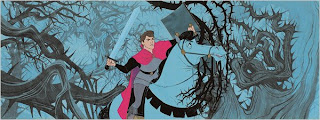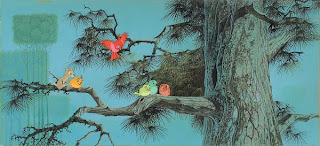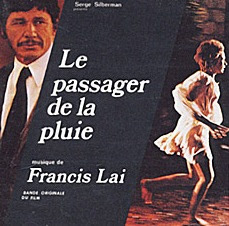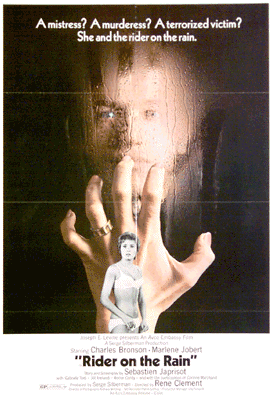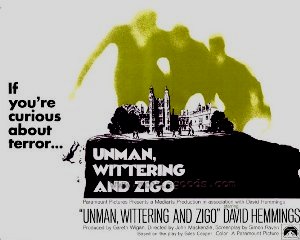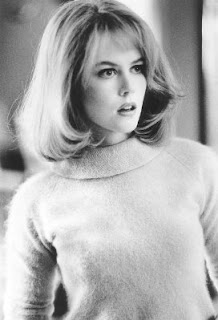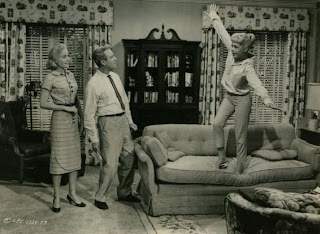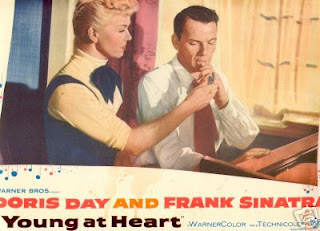 I've something of a love-hate relationship with Rodgers and Hammerstein - mostly love, of course. Who couldn't love their melodies?
I've something of a love-hate relationship with Rodgers and Hammerstein - mostly love, of course. Who couldn't love their melodies?But...
Case in point: Walter Lang's lavish widescreen version of the team's popular but problematic stage hit, airing Wednesday, November 26th at 10:45 p.m. (est). As is true with most of R&H's shows, the glorious songs are the point here. But are we really expected to forget the deadly dull stretches and arch dialogue that invariably come in between?
Some people do. Most people.
For the record, composer Richard Rodgers and lyricist Oscar Hammerstein collaborated on one original screen musical ("State Fair"), one musical conceived directly for television ("Cinderella") and nine stage musicals, six of which have been filmed. The shows that never made it to the big screen are "Allegro," "Me and Juliet" and "Pipe Dream."
The two "State Fair" films (1945 and 1962), "Carousel" (1956), "The King and I" and "The Sound of Music" (1965), for example, were all produced by 20th Century-Fox, while the films of "Oklahoma!" (1955) and "South Pacific" (1958) were produced independently by Rodgers and Hammerstein's own Magna Corporation but released by Fox. (They are now both owned by the Samuel Goldwyn Company.)
Only "Flower Drum Song" (1961) was made by another studio, Universal, and for me, it's the most durable of the Rodgers and Hammerstein films.
Hands-down.
The fact is, as grand as they may seem on the surface, just about every one of the beloved Rodgers and Hammerstein musicals comes with a nagging sense of déjà vu. This is something that's particularly evident on film because of the camera's relentless knack for picking up every flaw.
I call it The Rodgers & Hammerstein Formula.
"Oklahoma!" successfully introduced this formula, something that Rodgers and Hammerstein would slavishly rework and rehash for the rest of their careers together - namely, the confrontation between an innocent but headstrong young heroine (gingham-clad Laurie in the case of "Oklahoma!") and an incorrigibly sexist guy (cowboy Curly in the same piece). This basic theme would resurface between lovelorn Julie Jordan and petty criminal Billy Bigelow in "Carousel," between hayseed Nellie Forbush and shady Emil De Becque in "South Pacific" and between the title characters in "The King and I."
Even the modern, jazzy "Flower Drum Song" was affected by this by-the-numbers plotting, pairing sweet Mei Li with swinging Sammy Fong.
 If "The King and I," based on a true story, seems slightly more progressive than the team's musicals that preceded it, it's because at least its heroine, Anna Leonowens, is drawn as a mature, intelligent woman who's as savvy as the King and knows it. She doesn't take any guff from him; she doesn't back down. The battle of the sexes - something on which Rodgers and Hammerstein commented with some regularity - is much more evenly executed in "The King and I."
If "The King and I," based on a true story, seems slightly more progressive than the team's musicals that preceded it, it's because at least its heroine, Anna Leonowens, is drawn as a mature, intelligent woman who's as savvy as the King and knows it. She doesn't take any guff from him; she doesn't back down. The battle of the sexes - something on which Rodgers and Hammerstein commented with some regularity - is much more evenly executed in "The King and I."The show was a huge family success, both on stage and film.
So, it's little wonder that, toward the end of their united careers, when they were in need of a hit, the team did something shameless:
They ripped off "The King and I."
"The Sound of Music" may be based on a true story of its own, but it is a virtual clone of "The King and I," what with its story line about a man with a lot of children and the feisty woman who invades his household as the children's teacher. Along the way, she teaches the man something, too.
The similarities are striking, down to the heroine-sings-with-the-kids novelty numbers - "Getting To Know You" in "The King and I" and "Do-Re-Mi" in "The Sound of Music." Oddly enough, "The Sound of Music," a show not considered top-notch Rodgers and Hammerstein when it opened on Broadway, has managed to surpass its inspiration in terms of popularity.
Just as the use of children in "The King and I" revitalized Rodgers and Hammerstein's schtick, the addition of nuns and Nazis in "The Sound of Music" somehow made their formula even more irresistible to the public.
This formula, of course, doesn't stop with their plotting or characters. If their heroes and heroines are interchange-able from show to show, so are the big dramatic numbers - the songs with a message, if you will - that are always belted across by a secondary older female character.
In "Carousel," this big inspirational number is "You'll Never Walk Alone"; in "South Pacific," it's "Bali Hai"; in "The King and I," it's "Something Wonderful"; in "Flower Drum Song," it's "Love Look Away"; and in "The Sound of Music," it's "Climb E'vry Mountain." Not to diminish any of these songs - they're all genuinely beautiful, after all - but there's something gnawingly familiar in the way that they are all utilized.
Still, the assembly line quality of these songs is much less offensive than Rodgers and Hammerstein's penchant for always finding new ways to slip a wildly sexist song - one that denigrates women - into their shows.
At least, "The King and I" avoided this.
 We all know about "There Is Nothing Like a Dame" in "South Pacific," but in the same show, Nellie Forbush also gets to sing about what a silly little "Cockeyed Optimist" she is. It's a shrewd conceit about Rodgers and Hammerstein shows - having women sing sexist things about themselves.
We all know about "There Is Nothing Like a Dame" in "South Pacific," but in the same show, Nellie Forbush also gets to sing about what a silly little "Cockeyed Optimist" she is. It's a shrewd conceit about Rodgers and Hammerstein shows - having women sing sexist things about themselves.In "Flower Drum Song," for example, just about every condescending female stereotype is dragged out for Linda Low's "I Enjoy Being a Girl." In "Oklahoma!" Ado Annie sings that she's just "A Girl Who Can't Say No." During the big wedding scene in "The Sound of Music," the nun chorus does a reprise of "Maria": "How do you solve a problem like Maria?" How?
You marry her off, of course.
Even worse is Julie Jordan's "What's the Use of Wondrin'?" in "Carousel," in which all you women out there are advised to put up with grief and abuse because "he's your man and you love him so."
The topper, however, came in a song that was added to the 1962 remake of "State Fair" for musical veteran Alice Faye (making a comeback) to sing to her screen daughter, Pamela Tiffin. It's called "Never Say No." *
Here's how it goes:
"Never say "no' to a man
Simply avoid saying "yes' to him
That leaves the ultimate guess to him
Darling, don't ever say 'no'!"
(* - Rodgers wrote this one on his own after Hammerstein died.)
How's that for a musical invitation to date rape? (The makers of the constantly tourning stage version of "State Fair" have wisely elected to pass on this particular song for its current incarnation.)
There were never any equivalent songs for Rodgers and Hammerstein's male characters to address questionable things about themselves.
With the exception of "The Sound of Music," all of Rodgers and Hammerstein's stage musicals have been filmed with some fidelity to the originals (although "Carousel" and "The King and I" both had numbers deleted after their previews). In the case of "The Sound of Music," however, scenarist Ernest Lehman ("West Side Story") revamped the material with the active cooperation of Richard Rodgers. (Hammerstein was deceased by the time the 1965 Oscar-winner was made.)
 The changes that Lehman made didn't improve "The Sound of Music"; they only Disney-fied it. While the stage play had a certain rumpled maturity about it, the movie is all sun and sugar. (Christopher Plummer has called it "The Sound of Mucous.") Rodgers, for example, was encouraged to drop three of the less showy stage songs and replace them with new two ones, for which he wrote the music and lyrics - and both of which proved to be wildly mediocre.
The changes that Lehman made didn't improve "The Sound of Music"; they only Disney-fied it. While the stage play had a certain rumpled maturity about it, the movie is all sun and sugar. (Christopher Plummer has called it "The Sound of Mucous.") Rodgers, for example, was encouraged to drop three of the less showy stage songs and replace them with new two ones, for which he wrote the music and lyrics - and both of which proved to be wildly mediocre.Actually, "There's No Way To Stop It," one of the original songs to be eliminated from the film, is excellent and "How Can Love Survive" is the one (the only) truly adult song in the original score.
And the sturdy "An Ordinary Couple" is a far, far better song than the one that replaced it, the terminally inane "Something Good." Julie Andrews has noted how she and Plummer had a difficult time with "Something Good." "We kept getting the giggles," she reminisced.
One can understand why. The song is unsingable.
(Artwork: Richard Rodgers and Oscar Hammerstein on the dustjacket of "The Rodgers and Hammerstein Encyclopedia by Thomas S. Hischak; Nancy Kwan and company in the "Grant Avenue" number from "Flower Drum Song," the refreshing oddity in R&H's canon, and the poster art for "The King and I" and its companion film, "The Sound of Music")


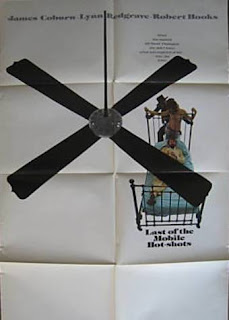


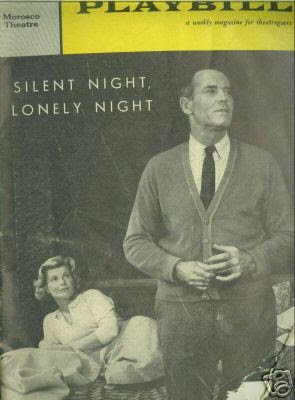

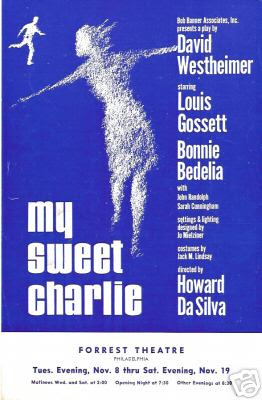


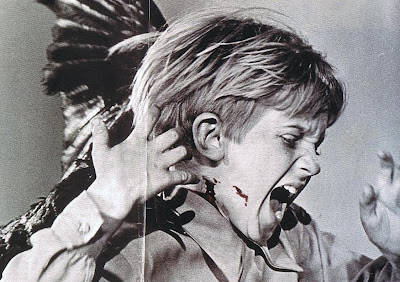


.jpg)



